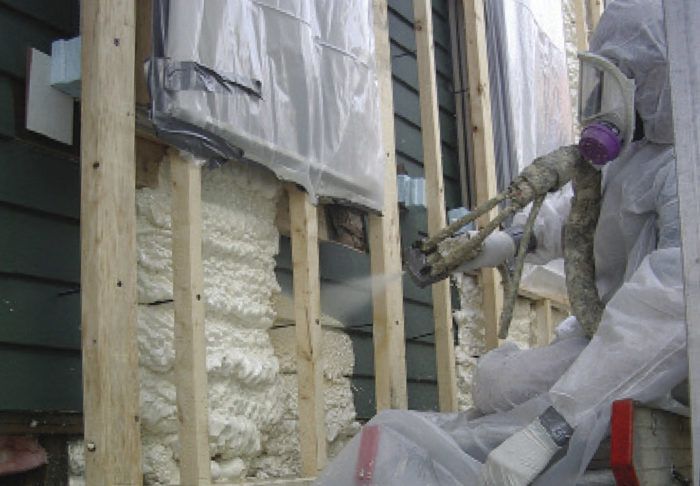Reconsidering R-value Recommendations
Does the dropping cost of solar PV systems mean that it's more economical to just install more PV panels and skimp on insulation?

When drawing up plans for net-zero homes, some builders refer back to an old paper from the Building Science Corporation for pointers on insulation thickness.
Titled “High R-Value Enclosures for High Performance Residential Buildings in All Climate Zones,” the paper has an oft-reproduced table with R-value recommendations for all climate zones in North America. These recommendations exceed requirements established by building codes, and they’re considered to be the R-value bible by some energy-smart builders.
But with photovoltaic (PV) panels falling in price, some experts have started to question the paper’s recommendations. Since the paper was written in 2010, the installed price of a residential PV system in the United States has dropped from about $4 to $5 per watt to about $2.75 to $3 per watt. For net-zero home designers, this price drop means that the cost of building a net-zero-energy home can sometimes be reduced by increasing the size of the PV system and lowering insulation R-values.
But here’s the rub: some of these designers misunderstood the original recommendations.
The paper, written by a group of authors including building scientists John Straube and Joseph Lstiburek, wasn’t about building net-zero homes; it was about production homes. And it didn’t even take the then-high price of PV into account. When builders and designers question the paper’s recommendations, they’re missing the point.
That said, the paper is over ten years old, and the facts on the ground have changed. So I decided that it was time to ask Straube and Lstiburek whether the dropping price of PV has changed their R-value recommendations in any way.
A reasonable guess
In writing their 2010 paper, Straube told me, “We were thinking about recommendations for single-family homes built by production builders who wanted to create homes with a minimum life-cycle cost for the homeowners.”
I asked Lstiburek how they came up with their table of recommended R-values. “When we created that table, we just guessed,” Lstiburek said. “I think we guessed reasonably well.”
But the concept of net zero wasn’t seriously considered in their recommendations, Lstiburek said. They were simply thinking of what seemed “reasonable and constructable” for production builders based on the technology and costs at the time.
“I think that if the cost of PV back then was what it is now, it would have been hard for us to ignore that factor,” Lstiburek told me. I pointed out that designers of net-zero-energy homes usually compare the cost of thicker insulation to that of a bigger PV system. “I don’t have any issues with that line of thinking,” Lstiburek said. “I’m not popular for saying this, but from my perspective, efficiency is efficiency.”
So, would the falling cost of PV cause him to change his R-value recommendations from 2010? Lstiburek’s answer: “Not really.”
A rational approach
I asked Straube if the R-values he recommended in 2010 still make sense in light of the plummeting cost of PV.
“The short answer to your question is that I think those numbers from 2010 are well within striking distance of what we’d recommend today,” he said. “Remember, those numbers were never based on PV versus insulation.”
But the question of PV versus enclosure is sensible to ask, he said. “Like many things we assess, we have to consider multiple requirements. We worry about comfort, resiliency after power outages, condensation control, and how many square feet are available for PV.”
As long as people are going through that list and making rational choices, Straube said he will be happy. “People need to use a rational approach. We’ll all reach different conclusions, because some people value some things more than others.”
Still, Straube isn’t ready to dial back on R-values, and doesn’t think the numbers he recommended in 2010 are aggressive. “There doesn’t seem to be a future where it makes sense to have thermally uncomfortable buildings or energy-inefficient buildings,” he said.
Playing the devil’s advocate, I noted that it doesn’t seem that energy codes in the United States are consistently enforced. But if they ever were, existing codes might not be far from a theoretical optimum level.
Straube said he can’t strongly disagree with that; it’s true in some places. “But code requirements are still a little on the low end. If you go that route…you’re just shooting low. If you increase the R-value of your enclosure, you might be able to specify an 18,000Btu/hr heat pump instead of a 32,000Btu/hr heat pump.”
I asked Straube, “What about Passivhaus levels of insulation?” He responded, “In most cases, I would say, ‘For sure, not.’ But I’ve always wondered about the answer to a basic question: What are the goals of Passivhaus? Is the idea to save resources? To reduce carbon emissions? Or to produce comfort? I don’t know what the goals of Passivhaus really are.”
“Net frigging metering”
Lstiburek and Straube both mentioned looming challenges for electric utilities. “A lot of people say, ‘I’ll just sell my excess PV power back to the utility,’” Lstiburek told me. “But the utility isn’t equipped to deal with it. Until we figure out a way to intelligently operate our utilities, I don’t think that PV will play a big role.”
Straube noted how quickly things have changed. “The future we spoke of a few decades ago has arrived,” he said. “These days, when we talk about PV, it’s all about the size of the array and aesthetics, not price. When it comes to PV production, the cost restraint has been removed. Now the problems are more about the grid.”
Straube said that he doesn’t know how that problem will be resolved.
“The only thing the future can’t be based on is net frigging metering,” Straube said. “Net metering is ridiculous. Net metering is not the future. I think we are moving to the spot where we will be able to leapfrog over net metering. Storage may become economical. If the price of batteries drops, and if the price of the grid gets too high, people could opt out of the grid-based system. Then this issue will become a political problem. If it ever makes sense for a new home to avoid connecting to the grid, the utilities will start financially imploding. At that point there will be a political intervention to make sure the grid exists.”
It’s lunacy
Lstiburek mentioned that the insulation levels installed on his own house are even higher than those recommended in his 2010 paper. “When we made those recommendations, we were thinking about what a production builder could do, as opposed to what a lunatic would do—someone like me or John, since we put ridiculous amounts of insulation on our own houses,” he said.
At one point in my conversation with Straube, I mentioned that the table from the 2010 paper is considered a bible by some readers of Fine Homebuilding’s sister website, greenbuildingadvisor.com. Reflecting on the fact that only a small minority of builders are interested in high R-value building enclosures, Straube responded, “I think it’s the bible for a very bizarre cult.”
|
“When we made those recommendations, we were thinking about what a production builder could do, as opposed to what a lunatic would do—someone like me or John.” Joseph Lstiburek |
 |
 |
“There doesn’t seem to be a future where it makes sense to have thermally uncomfortable John Straube |






View Comments
I read one of the papers and found it interesting but not convincing. Since my background is both finance and hi-tech manufacturing I wondered if anyone did a dynamic payback analysis. Those building to code are building structures with a relatively short life span and we are currently dealing with complex building products that may be found to be dangerous in the future.
If I get the chance to build another house, the walls will be 2x6 filled with Roxul; the outside will be either covered with 5/8" Dow Board and then Alside Charter Oak siding. Had a home about 350 yds. from the main line coming out of Cleveland, OH and 250 yds. from the Ohio Turnpike - what one will do for a good school system for their kids. We had a wind shear that removed about a third of my roof and heavily damaged the siding with flying debris. That is how I came up with the Dow Board, the siding and a Class A roof. The sounds from outside all but disappeared! I have no idea what the effect was on my heating bill since I did not follow it.